AMD Radeon HD 7870 GHz Edition & Radeon HD 7850 Review: Rounding Out Southern Islands
by Ryan Smith on March 5, 2012 12:01 AM ESTOverclocking: Power, Temp, & Noise
As with the rest of Southern Islands, AMD is making sure to promote the overclockability of their cards. And why not? So far we’ve seen every 7700 and 7900 card overclock by at least 12% on stock voltage, indicating there’s a surprising amount of headroom in these cards. The fact that performance has been scaling so well with overclocking only makes overclocking even more enticing. Who doesn’t want free performance?
So how does Pircairn and the 7800 series stack up compared to the 7700 and 7900 series when it comes to overclocking? Quite well actually; it easily lives up to the standards set by AMD’s previous Southern Islands cards.
| Radeon HD 7800 Series Overclocking | ||||
| AMD Radeon HD 7870 | AMD Radeon HD 7850 | |||
| Shipping Core Clock | 1000MHz | 860MHz | ||
| Shipping Memory Clock | 4.8GHz | 4.8GHz | ||
| Shipping Voltage | 1.219v | 1.213v | ||
| Overclock Core Clock | 1150MHz | 1050MHz | ||
| Overclock Memory Clock | 5.4GHz | 5.4GHz | ||
| Overclock Voltage | 1.219v | 1.213v | ||
Overall we were able to push our 7870 from 1000MHz to 1150MHz, representing a sizable 15% core overclock. This is now the 3rd SI card we’ve hit 1125MHz or 1150MHz – the other two being the 7970 and the 7770 – so AMD’s overclocking headroom has been extremely consistent for their upper tier cards.
As for memory overclocking, we hit 5.4GHz on both cards before general performance started to plateau, representing a 12.5% memory overclock. Considering that both cards use the same RAM on the same PCB, and the performance limitation is the memory bus itself, this is consistent with what we would have expected. With that said, we are a bit surprised that we got so far over 5GHz on 2Gb GDDR5 memory chips only rated for 5GHz in the first place; it indicates that Hynix’s GDDR5 production very mature.
With that said, because of the unique and non-retail nature of the 7850 AMD supplied us, the 7850 overclocking results should be considered low-confidence. The retail 7850 cards will be using simpler and no doubt cheaper coolers, PCBs, and VRMs; all of these can reduce the amount of overclocking headroom a card has. It’s by no means impossible that a 7850 could hit 1050MHz/5.4GHz, but it’s far more likely on a 7870 PCB than it is on a 7850 PCB.
Anyhow we’ll take a look at gaming performance in a moment, but in the meantime let’s take a look at what our overclocks do to power, temperature, and noise.
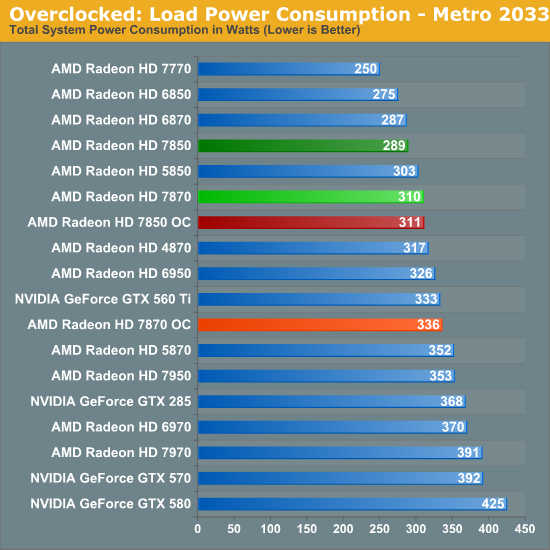
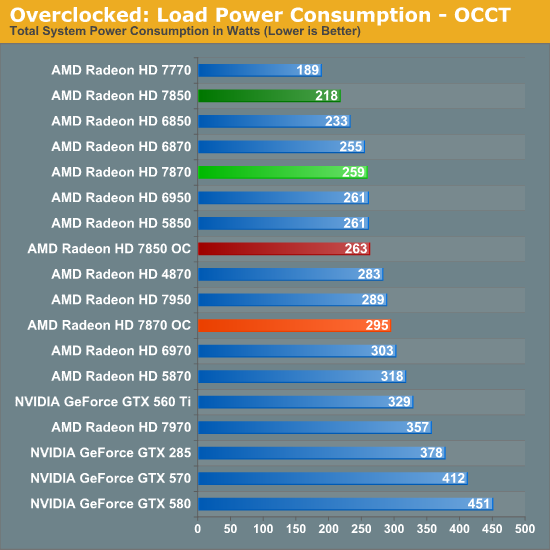
Even without a voltage increase overclocking does cause power consumption to go up, but not by a great deal. Under Metro the total difference is roughly 21W for the 7850 and 25W for the 7870, at least some of which can be traced back to the increased load on the CPU. Whereas on OCCT there’s a difference of nearly 40W on both cards, thanks to the increased PowerTune limits we’re using to avoid any kind of throttling when overclocked. All things considered with our overclocks power consumption for the 7850 approaches that of the 7870 and the 7870 approaches the GTX 560 Ti, which as we’ll see is a fairly small power consumption increase for the performance increase we’re getting.
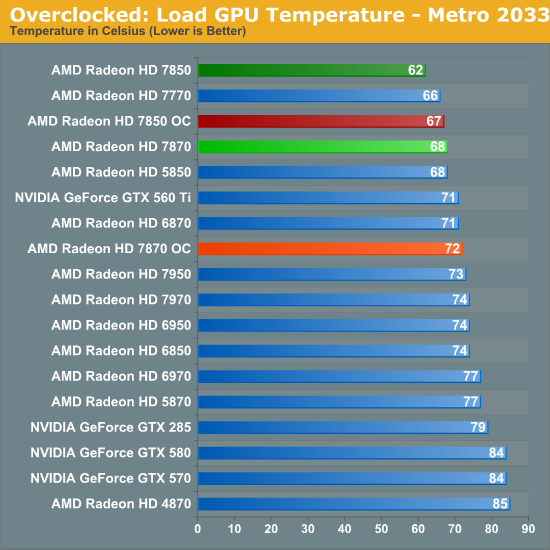
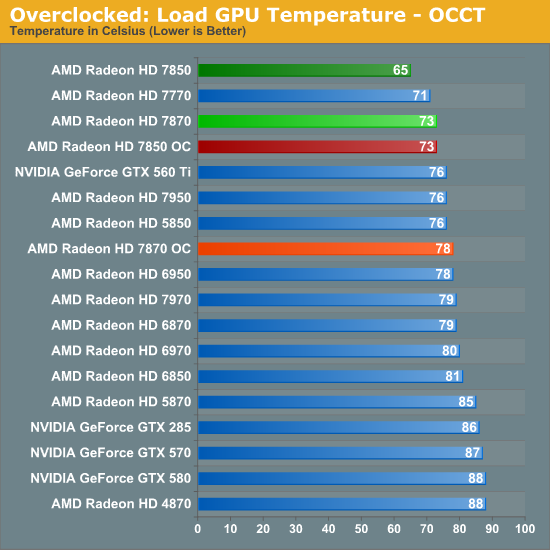
Of course when power consumption goes up so does temperature. For both cards under Metro and for the 7870 under OCCT this amounts to a 5C increase, while the 7850 rises 8C under Metro. However as with our regular temperature readings we would not suggest putting too much consideration into the 7950 numbers since it’s using a non-retail design.
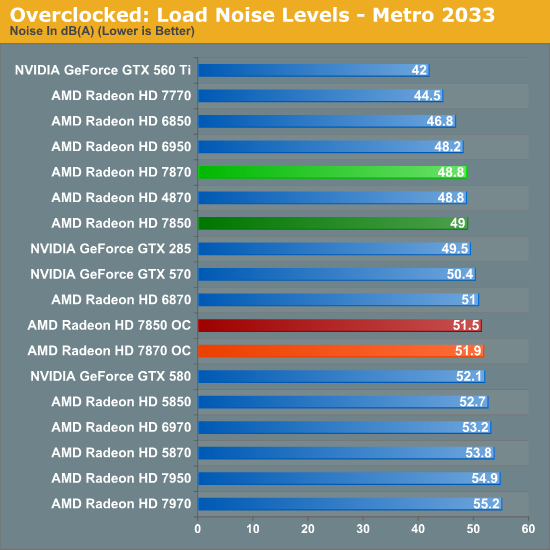
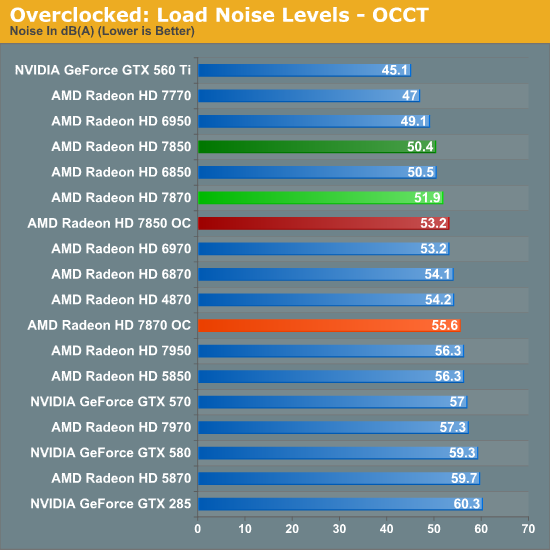
AMD’s conservative fan profiles mean that what are already somewhat loud cards get a bit louder, but in spite of what the earlier power draw differences would imply the increase in noise is rather limited. Paying particular attention to Metro 2033 here, the 7870 is just shy of 3dB louder at 51.9dB, while the 7850 increases by 2.7dB to 51.5dB. OCCT does end up being worse at 2.8dB and 3.7dB louder respectively, but keep in mind this is our pathological case with a much higher PowerTune limit.










173 Comments
View All Comments
DeViLzzz - Monday, March 5, 2012 - link
It is not the dumbest statement ever. Have you looked at multiple sites benchmarks ? Clearly a 2 GB 6950 Power Color flashed to a 6970 or a 6970 is worth keeping. Hardly an improvement over those situations for the price you would be paying for a 7870 and 7850.ExarKun333 - Monday, March 5, 2012 - link
Then you don't follow the graphic card industry very well at all.MadAd - Monday, March 5, 2012 - link
did i just read a different review? looking at this i did - Im on the 6950 and no theres not enough performance difference.also, comparing apples to oranges and saying theres a gain isnt going to work - if someones going to OC a 7*** then im sure they have also OC their 6***, so comparing a straight 6*** to the 7*** OC results and calling it a difference is smoke and mirrors.
cactusdog - Monday, March 5, 2012 - link
You guys dont get it. Why are you comparing the 7870 to a 6950? Should be the 6870 but even then The 7870 smashes the 6950 when overclocked. the 7870 performs like a stock 7970 when overclocked. You cant compare overclocking on the 6 series to the 7 series. The 7 series is the sandy bridge of GPUs.Why compare last gens high end to this gens mid range? If you have a 6950/6970 you should be looking at a 7950/7970. A 7950/7970 will give you 70% increase in performance when overclocked. AMD left heaps of overclocking headroom for easy overclocking.
Sure, the price is a little high now, but just wait a few weeks until Nvidia cards arrive and prices will come down. New tech is always a little expensive when it first comes out but no one is forcing you to buy now. Just wait a couple of weeks
Kiste - Tuesday, March 6, 2012 - link
"Why compare last gens high end to this gens mid range?"Because were introduced at the same price point. Video card names/numbers are completely arbitrary, you have to compare cards at a given price point.
xrror - Monday, March 5, 2012 - link
So I have one the the early 6950 2GB cards unlocked to 1536 shaders, and a 935/1275 overclock.Running at 1920x1200 in skyrim with the high resolution texture packs from Bethesda starts to lag.
Yes I'm being petty, but as a PC gaming smoe, I'm looking for a card that's under $300 that will dominate what I have.
I can't find a confident vote for a strong successor in the sub $300 range to replace my current card.
This makes me sad. Also with all the growing pains 69xx series had - and AMD's dumping of VLIW4 makes me pretty sure 69xx is a dead end for any future driver improvements.
Maybe I can sell my 6950 for $100 to subsidize a 79xx or a Kepler?
Zoomer - Wednesday, March 7, 2012 - link
I'll take it.mpschan - Monday, March 5, 2012 - link
I'd tend to agree with your assessment. Only those looking for bleeding edge performance should consider the upgrade to the 7900 series.The price/performance curve is a little disappointing, but not unexpected. This is what happens when you:
a) Move to a new process
b) Implement a new architecture
c) (Most importantly) Have no competition
They need to make their money back on the first two, and having no competition allows them to do that and then some.
But look at the thermals and power draw. Decreased power usage with a small gain in performance? Where have I seen that before ... oh I know, Intel!
Welcome to tick-tock folks. They took their process shrink and used it to allow them to draw less power, not tear up the performance charts.
This means the next generation on 28nm has room to expand. 1280 SP for the 7870 can be 1600 for the 8870. A 212mm2 die can be 300mm2. 190w can be 220w.
Ultimately the performance of these cards will come down to power drawn. The huge jumps in performance that we used to see existed because of drastically improving fabrication technologies combined with better ways of rendering screens. I think those days will be few and far between now.
arjuna1 - Monday, March 5, 2012 - link
You have a point, this generation is not worth spending the $$$ to "sidegrade". I don't kepler doing anything to change that other than forcing AMD to have decent prices.cactusdog - Monday, March 5, 2012 - link
How is a 7950/7970 a "sidegrade"?? To a 6950/6970? Its a massive performance increase. If you have a highend 6 series GPU you should be looking at highend 7 series. Not midrange.